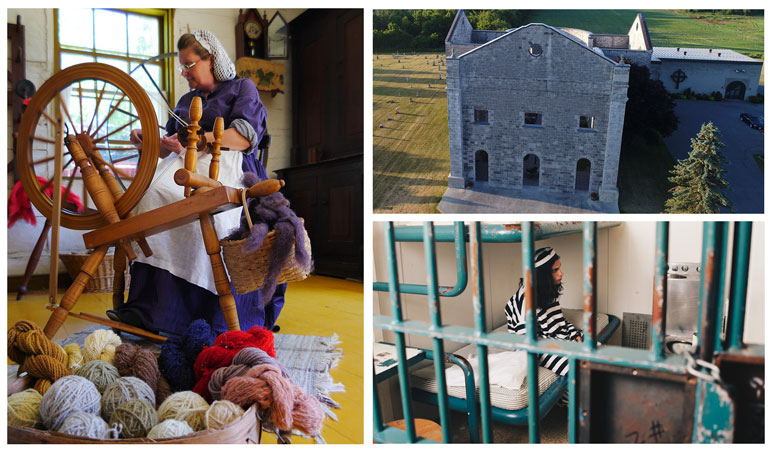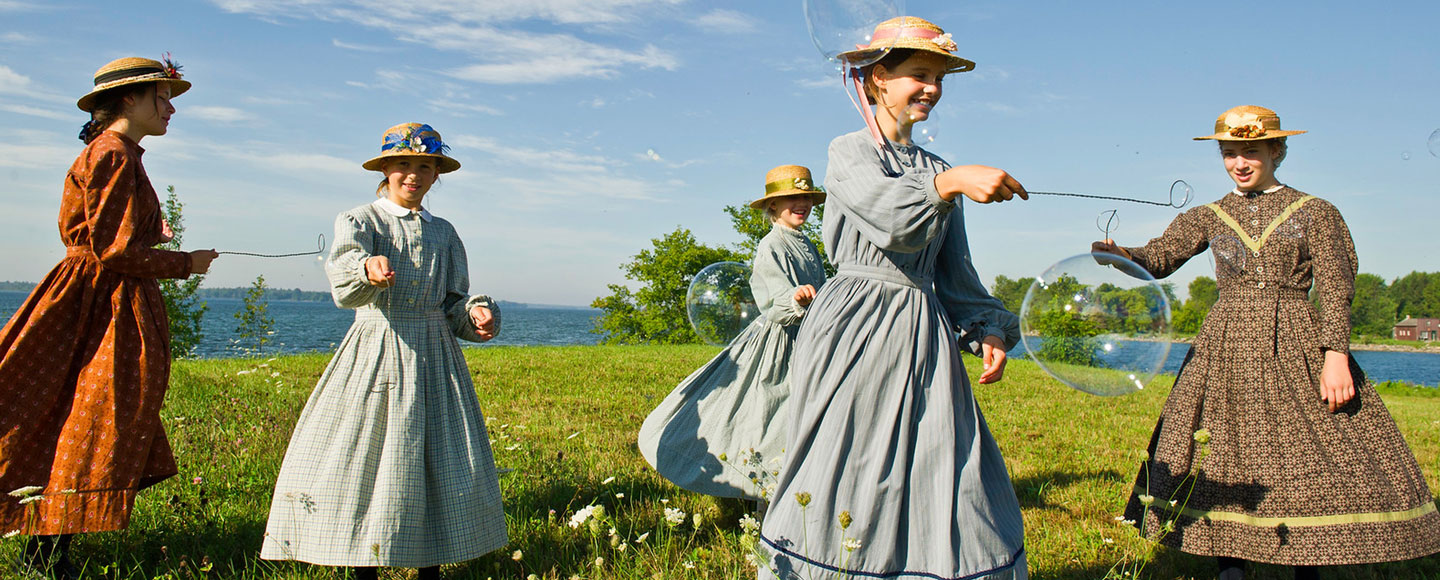There are many historical buildings and sites in the area, most of which you can visit and tour including the Cornwall Museum, the Historic SDG Jail and the St. Lawrence Seaway. The Cornwall Public Library has loads of historic records and is often a great resource for those doing ancestry research. Just a short drive out of town you can experience the world class Upper Canada Village and the Lost Villages Museum, both paying tribute to the way life used to be. Go back in time and learn about life in Cornwall and SDG Counties by visiting these attractions.

Tournée à pied du passé historique de Cornwall
Cornwall démontre son héritage par 40 plaques illustrées qui décrit l’histoire de la ville.
Chaque plaque présente des belles illustrations de moments hisotrique du passé de Cornwall. Individuellement, chaque plaque est impressionnante mais ensemble, elles forment une tapisserie qui se tissent à travers de la ville.
Les illustrations sont faites par l’artist Pierre Giroux. L’historienne Lily Worrall a completée la plupart de la recherche qui a été utilisée pour les illustrations.
La tournée commence dans le parc Lamoureux et démontre trois marches séparées qui peuvent êtres appréciées ensemble ou individuellement. Prenez une marche au long de long, dans le centre-ville et/ou dans le village.
Notre merveilleux Secteur Riverain
- Pont international de la Voie maritime
- Entrée Est du canal de Cornwall
- Canal de Cornwall
- Pont tournant de la rue Augustus
- Palais de justice et prison des comtés unis
- Hôpital Hôtel-Dieu
- L’usine Stormont
- L’usine de papier
- Pont de la New York Central Railway
- Écluse 19
- Construction du barrage hydroélectrique Moses-Saunders Power Dam
- Maple Grove
- Rapids Prince
- Carrières de Mille Roches
- Woodlands Santa Cruz
- Île Sheek/Sheik
Histoire du centre-ville de Cornwall
- Coin des rues Pitt et First
- New York Café
- Maison Rossmore
- Pierres du bureau de poste
- Hôtel King George
- Rue Pitt entre les rues Second et Third
- Le Grand Incendie
- Hôtel Cornwallis
- Cinéma Capitol
- Orphelinat de Cornwall
- Hôtel de ville
Le Village laisse sa marque
- Le tissu social du Village
- Le cinéma Roxy
- Cocathédrale de la Nativité de la Bienheureuse Vierge Marie
- Hôtel Royale
- Rue Race
- Cale sèche de Cornwall
- Manufactures de coton
- Courtaulds
Demandes spéciales
- La maison en pierre
- Fondation de New Johnstown
- Aréna communautaire de Cornwall
- Protéger de le canal de Cornwall
- Canadair T-133 Silver Star
- Don de tulipes
Des faits de la tournée
La tournée à pied du passé historique de Cornwall est un partenariat entre Le Village BIA, Downtown BIA, Heart of the City et la ville de Cornwall.
Distance: Approximativement 6 km
Temps pour completer: 90 minutes
Dimensions des plaques: 76 x 101cm
Poids des plaques: 7 kg
Artist: Pierre Giroux
Rechercheur: Lily Worrall
Musée communautaire de Cornwall
160, rue Water Ouest, Cornwall, ON
613-936-0280
Situé à l’intérieur d’une maison loyaliste restaurée datant de 1840 dans le parc Lamoureux, ce musée présente des documents d’archives et des expositions de meubles, de textiles et d’articles ménagers de différentes époques. La maison a été construite par William Wood en 1840. Le Musée communautaire de Cornwall propose littéralement un retour dans le passé.
Admission : GRATUITE
Temple de la renommée des sports de Cornwall
Découvrez l’impressionnant patrimoine sportif de Cornwall au Temple de la renommée des sports de Cornwall, situé dans le Complexe civique de Cornwall. Le Temple comprend des souvenirs et des photos d’athlètes notables, dont Newsy Lalonde, Dale Hawerchuck et Doug Gilmour, ainsi que de nombreuses vedettes d’autres sports.
Tous les deux ans, des nominations sont faites en vue d’une intronisation dans ce club exclusif. Il s’agit d’honorer ceux qui ont excellé dans le sport au sein de la communauté, ainsi que les ambassadeurs qui ont aidé à promouvoir les sports dans la région de Cornwall.
Entrée : GRATUIT
Adresse : 100, rue Water Est, ON K6H 6G4
Courriel : info@cornwallsportshalloffame.com
La prison historique de SDG
Le bâtiment de la prison du comté a été construit en 1833 et est resté opérationnel pendant 168 ans, jusqu’à sa fermeture en 2002. L’établissement accueillait des détenus de Cornwall et des comtés unis actuels de Stormont, Dundas et Glengarry. Des hommes, des femmes et des enfants de tous âges y étaient incarcérés pour divers types d’infractions, y compris des dettes et des meurtres.
Au fil des ans, cinq détenus ont été officiellement exécutés par pendaison, derrière les murs de la prison, pour les crimes dont ils avaient été reconnus coupables ; la dernière exécution a eu lieu en 1954.
La prison du comté est conservée presque dans le même état qu’au moment de sa fermeture, avec des objets historiques et des expositions disposées autour du bâtiment. Ce site historique est aujourd’hui considéré comme l’une des plus anciennes structures publiques de l’Ontario.
Visites guidées de juin à août
Adresse : 11, rue Water Ouest, Cornwall ON, K6J 1A1
Téléphone : 613-935-4891 613-935-4891 ou 1-844-814-JAIL
Courriel : jail@sdgcounties.ca
Upper Canada Village
Comment vivait-on et travaillait-on au XIXe siècle ? Upper Canada Village vous transporte dans les années 1860 grâce à des bâtiments authentiques, des interprètes costumés et des activités traditionnelles du XIXe siècle. L’expérience donne un aperçu de certains des défis et des récompenses de la vie quotidienne dans un petit village dans les années 1860.
Découvrez le cheval canadien, la vie quotidienne, l’agriculture, la religion, la musique, l’industrie manufacturière, les transports et bien d’autres choses encore !
Adresse : 13740 County Road 2, Morrisburg, ON, K0C 1X0
Téléphone : 1-800-437-2233 ou 613-543-4328
Courriel : getaway@parks.on.ca
Promenade du patrimoine
Les automobilistes peuvent profiter d’une belle promenade le long du fleuve Saint-Laurent en empruntant la promenade du patrimoine. La promenade du patrimoine, également connue sous le nom de route 2 ou de chemin de comté 2, s’étend d’Iroquois à l’ouest, en passant par Cornwall, et continue vers l’est jusqu’à la frontière du Québec. Elle traverse ainsi des villes comme Morrisburg, Ingleside, Long Sault, Glen Walter et Lancaster, reliant les parcs et les campings aux restaurants et aux détaillants. À Cornwall, la promenade est formée en partie par la promenade Vincent Massey, l’avenue Brookdale, la rue Water et le chemin de Montréal.
La promenade du patrimoine est signalée par des panneaux routiers bruns représentant un canon et les mots Promenade Heritage Parkway.
Histoire de la route
Autrefois principale route est-ouest traversant le sud de l’Ontario, la route 2 faisait à l’origine partie d’une série de routes à numérotation identique dans plusieurs provinces, qui reliaient Windsor (Ontario) à Halifax (Nouvelle-Écosse). En 1968, la plupart des voyageurs à la recherche d’un temps de parcours plus court ont été détournés vers l’autoroute 401 nouvellement construite. En 1972, les gouvernements de l’Ontario et du Québec ont désigné la Route 2, de Windsor à Rivière-du-Loup, comme Route des Pionniers. Cette désignation historique se reflète dans le nom local – Heritage Parkway.
Localement, la Heritage Parkway est considérée comme une route plus pittoresque, parfaite pour les excursions d’une journée et les voyages plus tranquilles.
Le Musée des villages perdus
Le Musée des villages perdus rend hommage aux communautés qui ont été perdues à jamais lors de l’inondation et de la construction de la Voie maritime du Saint-Laurent en 1958. Le musée se compose de dix bâtiments patrimoniaux qui ont été déplacés et restaurés dans le parc Ault à partir des villages perdus.
Les plaques historiques
En plus des plus de 40 nouvelles plaques qui composent le circuit historique, il y a des douzaines de plaques historiques à Cornwall et dans les cantons environnants qui commémorent des événements historiques, des personnes ou des bâtiments importants.
À Cornwall, il y a 14 plaques historiques. Ces plaques sont généralement de grands panneaux métalliques avec des motifs de couleur distincts : bleu et or (Ontario) et rouge et or (Canada).
Plaques historiques de l’Ontario
Cornwall Grammar School
Emplacement : 437, rue Sydney à Cornwall, à l’entrée de la Cornwall Collegiate and Vocational School.
La Cornwall Collegiate and Vocational School tire ses origines d’un établissement d’enseignement fondé par John Strachan en 1803. Strachan, un prêtre anglican, a ouvert une école privée dans sa maison où il espérait éduquer les jeunes hommes à assumer des rôles de premier plan dans la société. En 1806, il a construit une école qui, un an plus tard, est devenue l’un des premiers lycées de district financés par la province. De nombreux membres de l’élite du Haut-Canada ont reçu leur éducation sous la supervision respectée et progressiste de Strachan. Après son départ pour York (aujourd’hui Toronto) en 1812, plusieurs maîtres dirigent la Cornwall Grammar School. Avec la réforme provinciale de l’éducation en 1871, l’école est devenue la Cornwall High School et a entamé une nouvelle vie en tant qu’établissement secondaire moderne, devenant un collège en 1925 et ajoutant des cours professionnels en 1938.
Fondation de la Cornwall
Lieu : Dans le parc Lamoureux, au pied de la rue Augustus.
Au cours des années 1780, des soldats loyalistes démobilisés et leurs familles ont commencé à s’installer sur le site de Cornwall, qui s’appelait alors New Johnstown. La construction du canal de Cornwall entre 1834 et 1842 a accéléré le développement de la communauté en un centre industriel.
Capitaine Samuel Anderson 1736-1836
Emplacement : Sur le côté nord du chemin Montréal, juste à l’est de l’avenue Dunbar.
Vétéran de la guerre de Sept Ans et de la Révolution américaine, Anderson fut l’un des premiers colons à s’installer sur le site de l’actuelle ville de Cornwall. Au Haut-Canada, il a été juge de paix et premier juge du district de l’Est.
Présence française en Cornouailles
Lieu : Sur les terrains de l’Église de la Nativite de la Bienheureuse Vierge Marie, 300 Montreal Rd.
L’expansion industrielle à Cornwall à la fin des années 1870 a entraîné un afflux de travailleurs et de gens de métier du Québec. Au fil des ans, la communauté franco-ontarienne de Cornwall a affirmé sa spécificité culturelle et a accordé une attention particulière à l’éducation en français et à la préservation de la langue française.


